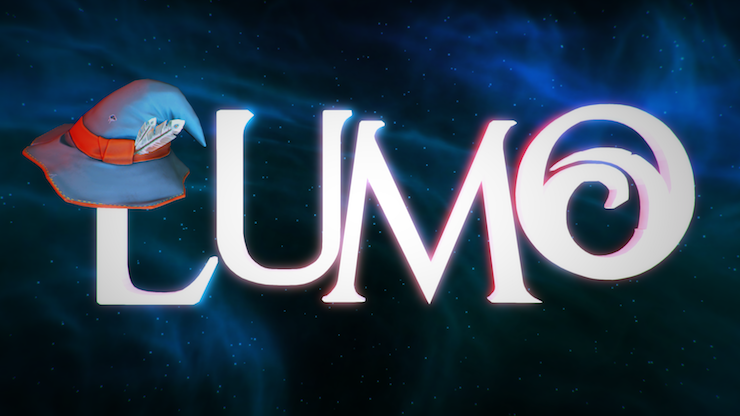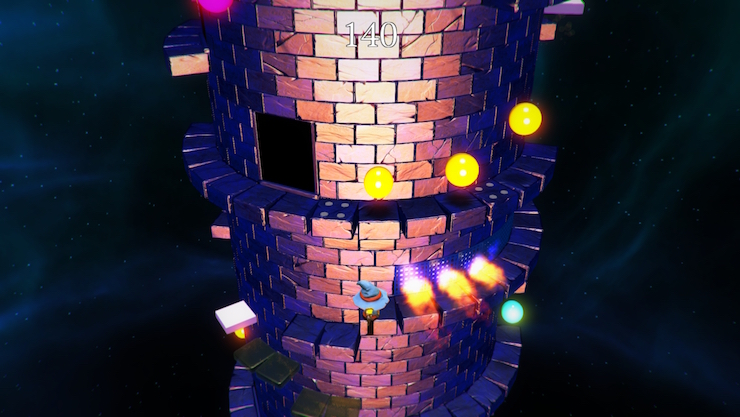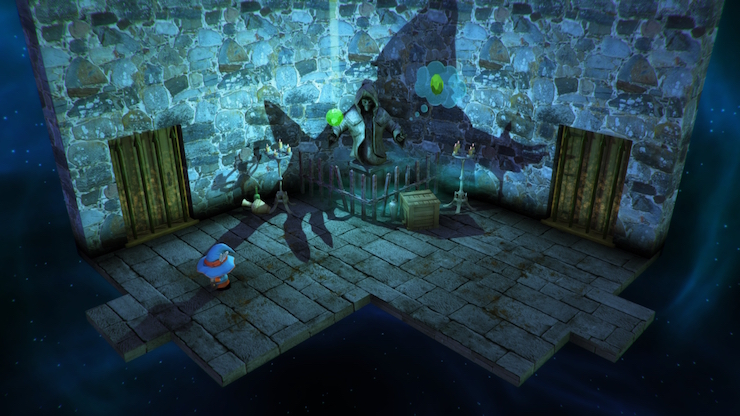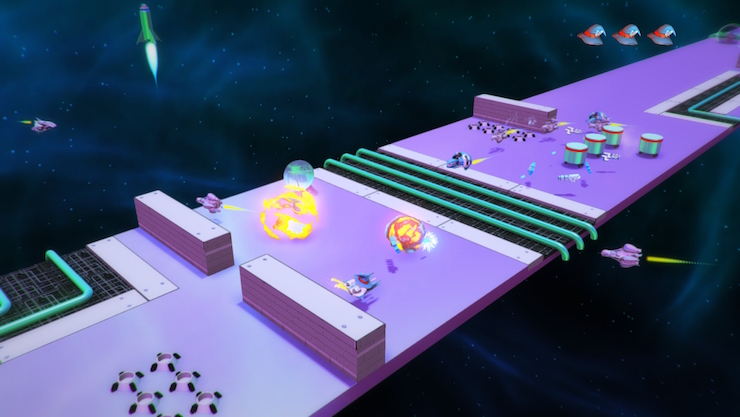No matter how vivid or hazy the memories may be, we all remember playing our first computer game. There was that one spark that started it all, and for me it was playing on my dad’s ZX Spectrum. Those moments playing on games like Punch and Judy and Boulder Dash opened my eyes to a completely new world, and from that moment I knew there was no turning back.
I recently spoke with game developer and industry veteran Gareth Noyce about his upcoming game, Lumo. Whilst talking to him, it became clear how passionate he is about making video games and how important they are to him. We tend to forget that there are real people behind video games, made up of blood, pixels and tears, people like you and I that love playing video games, people that have those memories of welcoming video games into their hearts for the first time.
Lumo is an addictive, isometric puzzle platformer that sees you take control of a little guy in a magician’s hat who travels through zone after zone, encountering different scenarios that push you to the limit. At its core is a simple yet fun game that will have you solving its wide range of puzzles over and over again. So where did the idea come from and how did Gareth’s love of old school video games come full circle?
“I’d always wanted to make an Isometric game. I loved all of Jon Ritman and Bernie Drummand’s stuff, right up to Monster Max – Head Over Heels being the first game that I actually purchased (still have it to this day). So, it’d always been in the back of my mind as something to try, but, you know, not something that I’d ever really pitched anywhere. It’s such an old school idea.
“Then, by chance, I ended up having a chat with Ste Pickford from Zee3 on Twitter about his old SNES Iso game: Equinox. I spent a whole summer trying to beat that game so knew it quite well. He’d found a bunch of speed runs and was amazed by how fast people could get through the game, and I’d actually stumbled upon one a while back and shared it with him. We got talking about all those old Isometric games and I said that I always fancied making one. He was really encouraging about it so I knocked up a quick prototype and it immediately felt right. Kind of like going full circle; my first solo game being the same genre as the first home computer game I owned. It almost seemed like it was meant to be.”
As I previously mentioned, my very first experiences with games and gaming came in the form of my dad’s ZX Spectrum, so a lot of Gareth’s references to old school gaming were familiar. I remember playing games like Hades Nebula, Repton and 1942 and being completely infatuated with them. We talked further on his love of old games and how important video games are to him.
“I can remember my first arcade experience, the first time I used a friend’s Spectrum, all that stuff was kind of magic in the 80s. Reading Your Sinclair, Amstrad Action, Zzap64 – all those mags – cover to cover, really absorbed in the whole thing. The developer diaries were like a view into another world and, well, I was kind of obsessed with games from the get-go. I always knew this was what I wanted to do, that I wanted to try and make games no matter how big or small. Computers were just this fascinating, powerful doorway.
“I guess it’s hard to say if there was one game, but Head Over Heels was the first one that I bought. It was the first that I drew silly little rooms for, the first that I knew so well that I could complete it on every play-through, but it’s not really the sole reason. In all honesty it’s something that just grew and grew over time. Staring at AM2’s Arcades, being amazed by the Amiga, I mean, there’s really just so much stuff that was mind-blowing about the computing revolution from the 80s
to the 90s (and today) that – as a kid and a teenager – it was just an exciting path.”
In the 30 minute build of Lumo that I got to play, I explored 38 rooms, died 53 times and travelled 2.27 kilometres, which apparently is pretty good for 30 minutes (although I think the game was just being polite). Along the way, I saw contraptions of fire that reminded me of Super Mario Bros. and zones that took inspiration from old games like Marble Madness. The nostalgia and humour present was really appreciated as well (like hearing Whistlin’ Rick Wilson’s ‘Hold My Hand Very Tightly (Very Tightly) in a lift), and I cannot wait to play the game when it is finished. Gareth has made a game that not only brings something fresh to the table, but also pays homage to the great games that made him the developer he is today.
“Lumo is very much a love letter – a salute to that whole 80s industry that the UK had; the personalities, the devs, the games, the magazines – everything about that scene was so magical and got its hooks into me. It’s not the core of the game, but it’s there on the side to (hopefully) surprise and delight anyone who grew up with it.”
Something that struck me on my playthrough was the diversity in level design and the amount of different zones that were present. The recent trailer shows even more of what to expect from the completed game, and it was interesting to find out what the process was for coming up with all of these ideas.
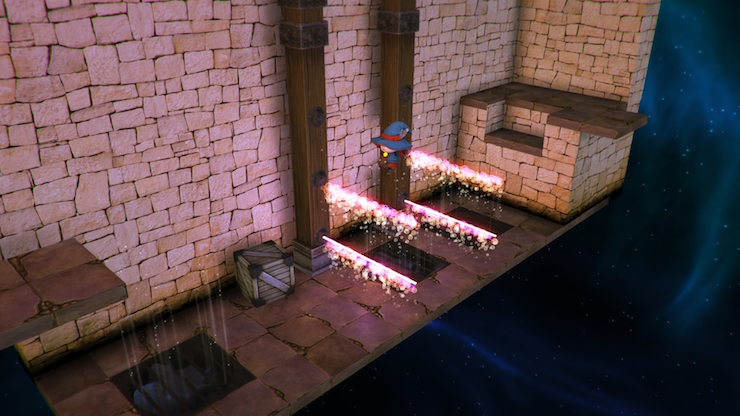 “When I started I made a list of mechanics and ideas that I’ve slowly implemented over the period I’ve been working on it. The structure of the game; how the zones fitted together, the ordering of things, and when and where things are re-used has been a bit more organic, but I did know how many areas there’d be and how they’d work together very early on. The tone changed slightly (especially how it was lit) to move away from dark and spooky to what it is now, but I think that was just a natural process of finding the right language for the game. It was supposed to be playful, so that Scooby Doo thing was the wrong direction.”
“When I started I made a list of mechanics and ideas that I’ve slowly implemented over the period I’ve been working on it. The structure of the game; how the zones fitted together, the ordering of things, and when and where things are re-used has been a bit more organic, but I did know how many areas there’d be and how they’d work together very early on. The tone changed slightly (especially how it was lit) to move away from dark and spooky to what it is now, but I think that was just a natural process of finding the right language for the game. It was supposed to be playful, so that Scooby Doo thing was the wrong direction.”
It clearly has many influences, and one that we talked about completely embodies how the game looked and felt to me.
“You remember the old TV programme, Knightmare? That was definitely in my head at one point. That was more of an influence initially, but when I brightened up the game it kind of took on a different sort of feel. I ended up really doing that as a sort of evolutionary thing – what sort of worked and felt right over time.”
As the interview went on, Gareth talked more about the game’s evolution from a concept to a reality, and how happy accidents and new ideas affected the game’s development.
“Some of the evolution of the game’s flow has been a reaction to watching others play it – so game balance, essentially – but most of it has been me looking for a way to keep the game fresh. Ensuring that you keep seeing new things, and that the desire to move forward and explore stays with the player. I’ve tried to avoid overuse of mechanics and to have each zone contain a consistent set of things that you play with, each with their own set of rules. It’s fairly basic, but I want the game world to feel like somewhere that could exist and be explored.
“I’ve not worked on the game in a linear fashion (i.e. built it from the start to the end), I’ve jumped about, making things as the mood has taken me, and for periods at the start of development there were large parts of each zone ‘working’ but not connected as an actual ‘game, so there’s been a tiny bit of re-ordering as things have progressed, or as I’ve added new ideas. And of course, there are always happy accidents as you play around with the parameters of the things that are built. These always get put into the game in some fashion.”
Porting is also a possibility. When talking about a potential release date (hopefully Q1 of 2016), Gareth was good enough to share a bit of information about what other devices we may see Lumo on.
“I don’t think RSG (Rising Star Games) has announced what platforms it’s on, but we are absolutely looking at all console versions. It has run on Vita and PlayStation 4. I really want to get it on every platform if possible. I think it’s a good game that can find an audience on all of those devices, so we are working at that. Like anything, we need to do a bunch of work to know it’s going to run at a decent speed and look ok.”
Gareth Noyce has been a part of some huge AAA titles in his time (Fable 2, Project Gotham Racing 3, Too Human), but being the sole developer of Lumo means that the process is very different. It was refreshing to hear someone talk with a real honesty about his experiences of making a game alone. The game isn’t 100% complete, and Gareth knows there are still obstacles in his way.
“It’s not necessarily come together as a game yet. You can see all the stuff you have yet to build, and that is quite a dark place when you are on your own. You feel a bit stressed and you feel you have a big hill to climb, and right now I’ve got a lot of stuff to do to get it content complete so that we can do the various console versions and stuff. I’m a little bit under pressure at the minute, but I can see the game is there now. It is different from working in a team. My girlfriend supports me a lot, but I can’t just go and moan to someone across the room. It’s all on me – I have to do it.”
Gareth is a humble individual, and so close to release it is only natural for nerves to set in. It was interesting to hear what Gareth was most nervous about, and how there is more to game development than deadlines and coding; the personal journey of getting a beloved idea from the paper to the computer screen.
“I’m really nervous about the reaction. I’ve done this loads of times now and it’s weird because I guess if you’re working in a team and the game’s not received well you can take it on the chin and you can understand your mistakes. Everyone can except that it maybe didn’t go the way we planned, but when you’re doing it alone – if the game comes out and everyone hates it, it’s going to be like ‘Oh my God,’ so I’m really worried about that.
“It’s weird because this feels so much more personal because there is so much more of me in it. My sense of humour is just all over it because I’ve just tried to make myself laugh most of the time. So if I think of a bad joke and I can squeeze it in I will do it, just because I find it amusing. It’s a little bit different because a lot of the other stuff gets sanitised because of a bigger budget for bigger corporations for a bigger audience. Some of this stuff may fall flat – people might not like the tone of it – I don’t know. So yeah, very nervous about it. I want people to find it and I want people to have fun with it and I want people to enjoy it in the way that I do, which hopefully they will. I’m trying not to be too pessimistic about it, but it’s a fear.”
With the end in sight, Gareth is looking forward to take a well-earned breather, and already thinking about his next move.
“It will be nice to have a couple of weeks not stuck in this room on the computer – just be able to stick my head up and catch up with games I’ve missed and really look around at what other people are doing. If it goes OK and the money works out for the second project I’ve got a bunch of ideas for other games I want to make so it’s kind of exciting to be on the threshold of ‘OK, maybe I can do another title and maybe realise some of these other ideas.’ I guess it’s like excited nerves. It’s a rollercoaster ride and seeing everybody scream as they’re going down it, but I’ve still got to do that.”
Gareth Noyce is a great guy – who keeps his ketchup in the fridge like all the best of us – and has made a game that will be an absolute joy to play when it is released. It reminds me of my childhood – of those memories that I hold dear, and of all those times that I turned to video games to escape the humdrum rigmarole of growing up.


